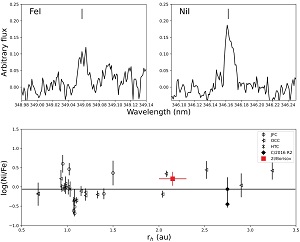- Details
- Published on 25 June 2021
Vol. 650
1. Letter to the Editor
The similarity of the interstellar comet 2I/Borisov to Solar System comets from high-resolution optical spectroscopy

Discovered in August 2019 on an orbit with an eccentricity in excess of 3, and showing signs of activity already at discovery, comet 2I/ Borisov is the first comet of unambiguous interstellar origin. Previous spectroscopic studies at visible-to-radio wavelengths have led to the detection of several atomic, radical, and molecular features due to CN, C2, NH, [OI], NH2, OH, HCN, CO, and most recently atomic Ni, overall indicative of a composition similar to that of CO-rich and carbon-chain depleted Solar System comets. Using UVES at the VLT for a total of ~21 hours, Opitom et al. reobserved all of the abovementioned atomic and radical species in the coma of 2I/Borisov, and they report for the first time the detection of CH, [FeI], and additional forbidden lines due to [OI], while C3 and several ionic species remain undetected. These new observations enable the first determination of the Fe/Ni relative abundance, the ortho-to-para ratio of NH2, and the green-to-red (G/R) line ratio of atomic oxygen in 2I/Borisov. In these respects, and except for a high G/R ratio, which is presumably related to its CO abundance, 2I/Borisov does not appear to stand out from solar system comets, pointing to a similarity of environments between its unknown birthplace and those of CO-rich comets in our own Solar System.


